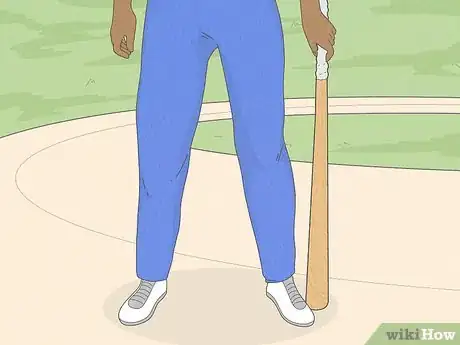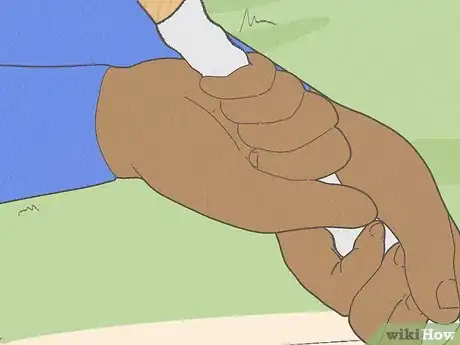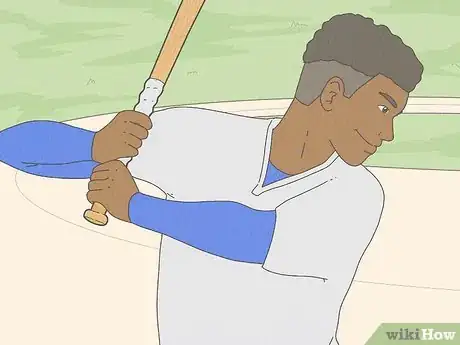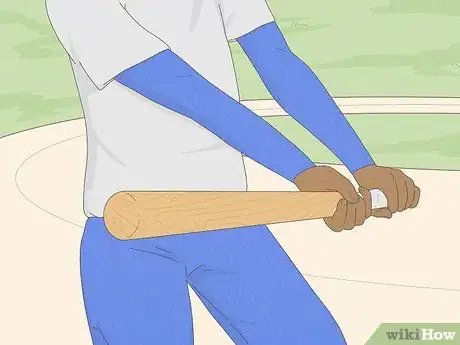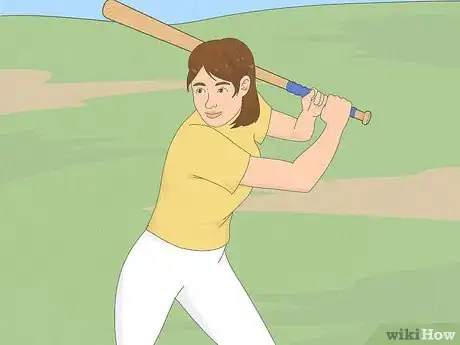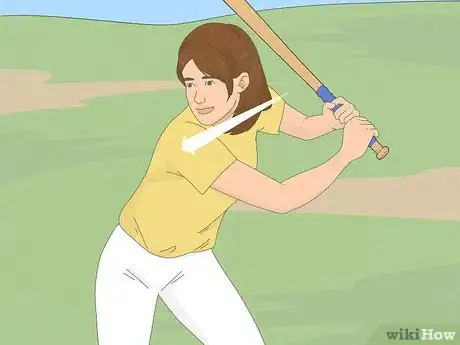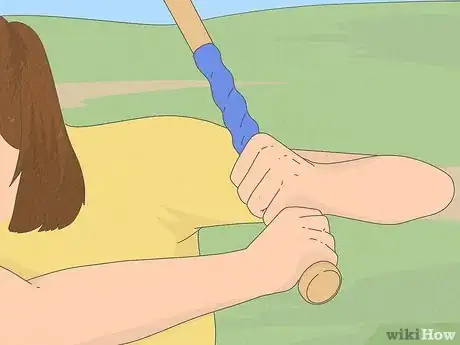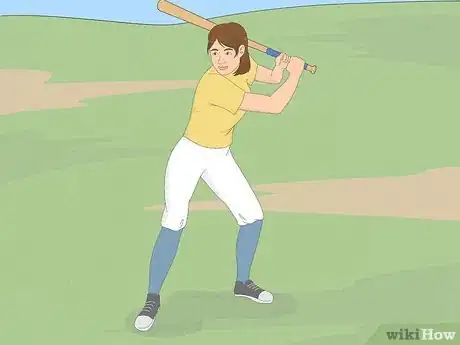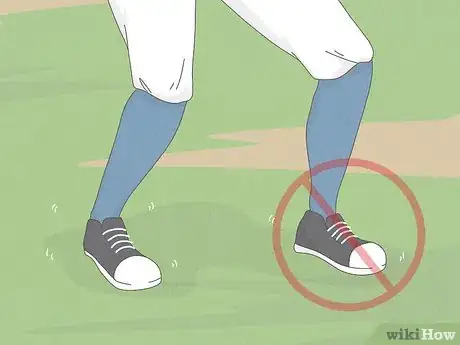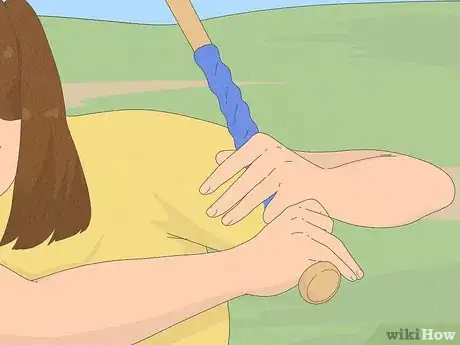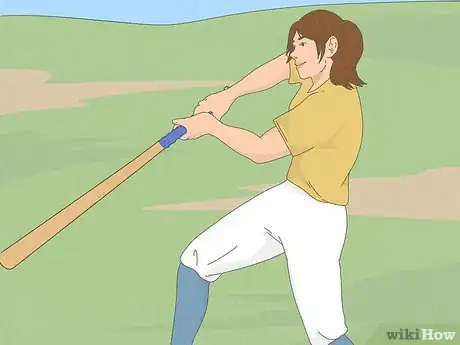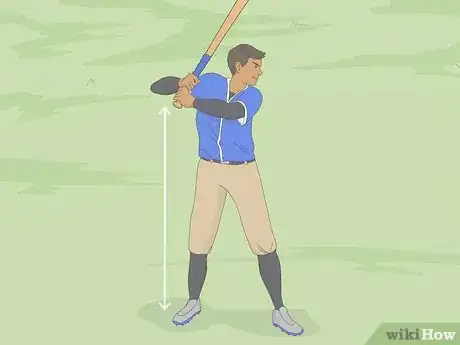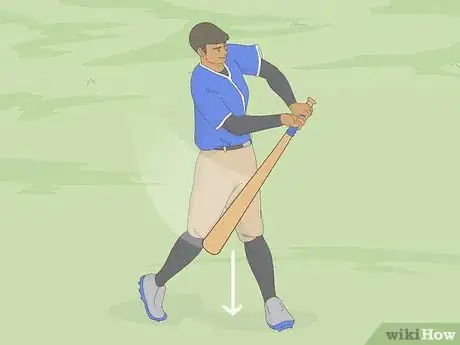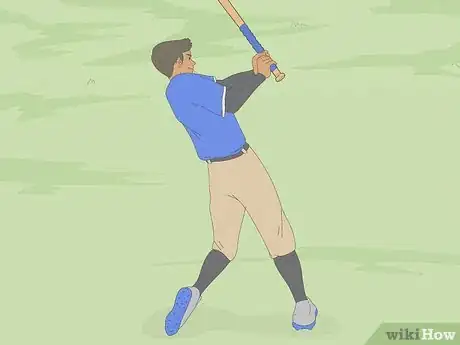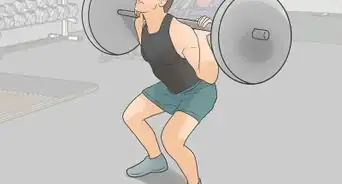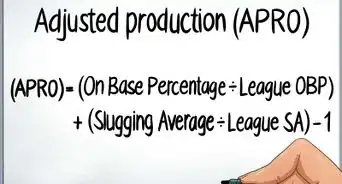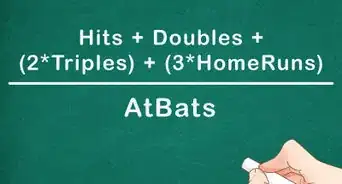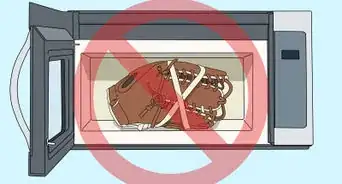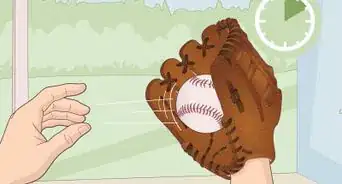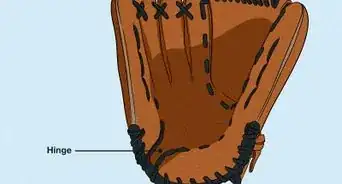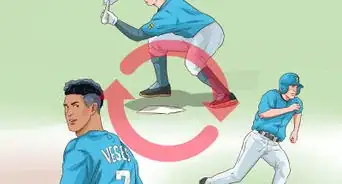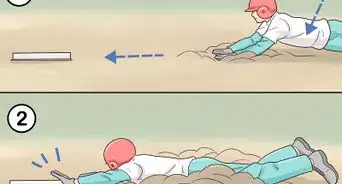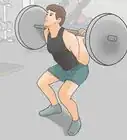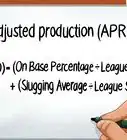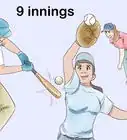This article was co-authored by wikiHow Staff. Our trained team of editors and researchers validate articles for accuracy and comprehensiveness. wikiHow's Content Management Team carefully monitors the work from our editorial staff to ensure that each article is backed by trusted research and meets our high quality standards.
The wikiHow Video Team also followed the article's instructions and verified that they work.
This article has been viewed 69,923 times.
Learn more...
Correcting your grip will increase your bat speed and create more of a whipping motion to drive through the baseball. Your entire body should be more relaxed but your bat should be in a stronger position upon contact. A weak grip can result in your bat slowing down or bouncing off the ball to produce a weak hit. A good grip will also allow you to make adjustments with your hands if the pitch has fooled you.
Steps
Finding Your Grip
-
1Place the handle correctly. Place the head of the bat on the ground in front of your lead foot. Grab the handle with your bottom hand or non-dominant hand. For example, if you are a right-handed hitter, your bottom hand and lead foot will be your left.
- This creates a slight angle to your bet which helps generate an extra whip to your wrist.
-
2Arrange the fingers of your bottom hand. Bend the index finger of your bottom hand around the bat. Separate the bottom three fingers that are also wrapped around the handle. Point your knuckle up the barrel of the bat.
- Try to keep the bat off of the palm of your hand as you hold it with your fingers.
Advertisement -
3Grip the bat with your top hand. Grab the handle similar to your bottom hand, with the handle in your fingers. Your index finger should be separate from the bottom three fingers but all four fingers should be gripping the handle with your thumb in a comfortable position.
- The second knuckles of your fingers should basically be all aligned.
-
4Keep the bat light. Keep your grip relaxed as you hold the bat. Your grip will automatically tighten through the swing motion. Your grip will be the strongest as you make contact through the baseball. Focus on a light grip as you begin your swing.
- Keeping a tight grip will create fatigue in your fingers and muscles. It will also result in a slower, weaker swing. Grip with your fingers and pad of your hands.[1]
-
5Use your wrists correctly. Your grip needs to enable your wrists to move well so that you can properly create bat lag and deliver the bat head to the ball. Bat lag is the relationship of your hands to the head of the bat as your swing progresses through contact. As you swing, your hands will come forward but your bat head will be left behind.[2]
- The bat head is whipped around at the last instant by your wrists, but primarily by the wrist of your top hand. You want to generate as much bat speed through this whipping action and an improper grip can inhibit your wrists from generating the full potential.
Finding Your Swing
-
1Relax your body. Your upper body should mimic your grip and be relaxed. The more explosive the movement, the more relaxed your body needs to be. You want to uncoil your muscles and explode into your hit.
-
2Adjust your shoulders. Make sure your shoulders aren’t level. You want there to be some tilt to your shoulders to create some explosion.[3]
-
3Find your strongest grip. Look at where your bat will make contact relative to where you have your hands gripped on the handle. The strongest grip is when the palm of your top hand is facing up and the palm of your bottom hand is facing down.
- Your hands should be parallel to the ground if you open both your hands. The thumb of your top hand will prevent the bat from getting knocked backwards as your grip tightens to make contact with the baseball.
- The range of your knuckles should allow you to make contact with the ball with one palm up and the other down. To find this, pick your bat up and align your middle knuckles. Take a half swing, as if you’re making contact with the ball, and hold the position. How are you gripping the bat?[4]
-
4Get in your batting stance. You should be balanced with your weight on the balls of your feet as you slightly bend your knees. Stand slightly wider than shoulder width apart to ensure your lower body is properly engaged and ready to engage into your hit. You want to take a short stride as your lower body rotates with the rest of your upper body to create maximum power for your hit.[5]
- Avoid leaning back on your heels because it will make it difficult to keep balance as you move forward into your swing. Having too much weight transfer as you uncoil into your hit will reduce your speed and power.
- Don’t keep your feet too close together because it might be difficult to keep your head level, time the pitch, keep your balance, and adjust to pitches that are off-speed. Having your feet too close together is known as overstriding and is common amongst beginners. In contrast, if your feet are too wide apart, you will decrease your power because you won’t be using your entire weight as your body rotates into your swing.
- Open up your stance if you are having problems seeing the pitcher and the ball. You want to be able to see the ball with both eyes.
-
5Avoid excess movement. Keep your hands at the top of the strike zone and your feet slightly more than shoulder width apart. You want you swing to be fluid through the strike zone. Any small adjustment will decrease your speed and your power.[6]
- Avoid getting “happy feet”. This means moving around when already in your batting stance. The added movement can disrupt your timing. Relax and focus on the pitch.
-
6Ensure you have palm up and palm down upon contact. Play around with your grip so that you feel the effect when you have one palm up and one down when you make contact with the ball. One grip may feel easier than the other.[7]
- You may find that if you align your middle knuckles your wrist rolls too early. You may find that if you align the middle knuckles of your bottom hand with the big knuckles of your top hand you have hard time holding on to the bat upon contact. You may also find yourself becoming more tense and forcing your shoulders to tilt in order to get into position rather than allowing a more natural motion. The size of your hands may cause you to adjust your grip to find your natural swing.[8]
-
7Troubleshoot your problems. You need to be confident and comfortable with your grip so don’t be afraid to slightly adjust when you’re consistently running into the same problems. You may be rolling your wrists early if you are topping the ball. Close your grip by bringing the middle knuckles of your bottom hand closer to the big knuckles of the top hand.[9]
- Bringing your middle knuckles closer may aid you in coming through a better path through the hit zone. This can prevent constant pop ups. A tight grip may create unneeded tension in a swing and reduce your power. This may be the first reason why you are having difficulty hitting. There may be many reasons why you are finding problems but first focus on finding a grip you are comfortable with.[10]
Finding the Right Bat Angle
-
1Angle your bat perpendicular to the ground. The angle of your bat as you stand ready with the bat cocked back factors into how effective of a hitter you are. Angle your bat straight up and down. This creates a loop in your swing.
- The extra length in the back swing generates more power from this position because you’re increasing the space to speed up your bat.
-
2Position your bat parallel to the ground. Lay the bat flat and parallel to the ground as it is ready to explode into your swing. This shortens the back part of your swing and creates a direct path to the pitch.
- Because your bat is travelling a shorter distance than if it were angled up, you will not generate as much power.
-
3Use an angle between straight up and lying flat. Find an angle that is comfortable to you. Most people find an angle that is in between parallel to the ground and straight up. This will depend on what type of hitter you are and how you intend to control the baseball bat.
Community Q&A
-
QuestionHow much space between the top hand and lower hand?
 DonaganTop AnswererYour swing will be easier if your hands touch each other on the bat handle.
DonaganTop AnswererYour swing will be easier if your hands touch each other on the bat handle.
Warnings
- If you're using a metal bat, you will feel a tingling in your hands when you hit the ball.⧼thumbs_response⧽
References
- ↑ http://www.qcbaseball.com/hitting/hitting-grip.aspx
- ↑ http://www.qcbaseball.com/hitting/hitting-grip.aspx
- ↑ http://www.qcbaseball.com/hitting/hitting-grip.aspx
- ↑ http://www.qcbaseball.com/hitting/hitting-grip.aspx
- ↑ http://www.qcbaseball.com/hitting/hitting-batting-stance.aspx
- ↑ http://www.qcbaseball.com/hitting/hitting-batting-stance.aspx
- ↑ http://www.qcbaseball.com/hitting/hitting-grip.aspx
- ↑ http://www.qcbaseball.com/hitting/hitting-grip.aspx
- ↑ http://www.qcbaseball.com/hitting/hitting-grip.aspx
About This Article
To grip a baseball bat, start by placing the head of the bat on the ground in front of your lead foot. Then, grab the handle with your non-dominant hand, holding it with your fingers and not your palm. Finally, grip the bat with your dominant hand above your lower hand, aligning the second knuckle of all your fingers. Try to keep your grip relaxed since a tight grip can tire out your hands and result in a slow, weak swing. To learn how to swing a baseball bat, scroll down!
